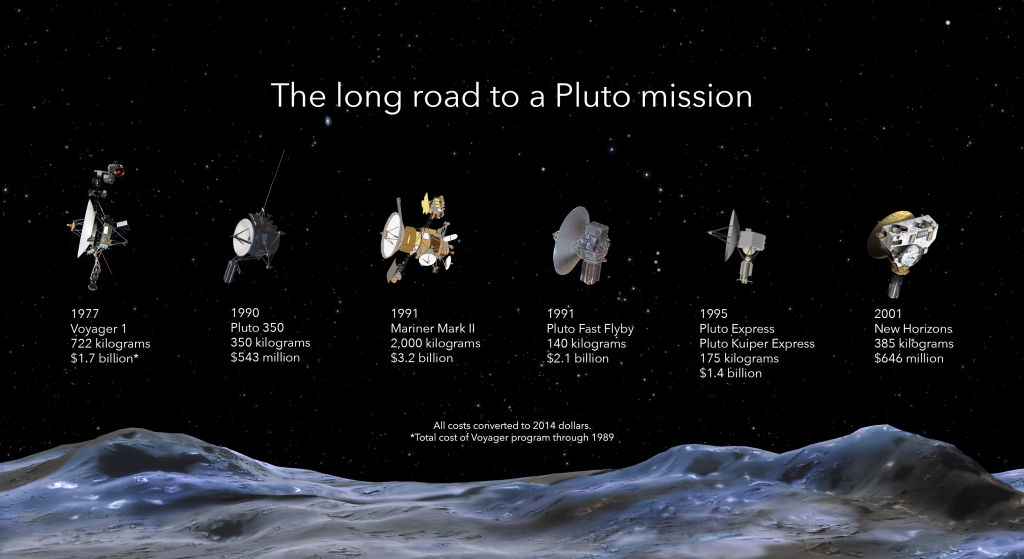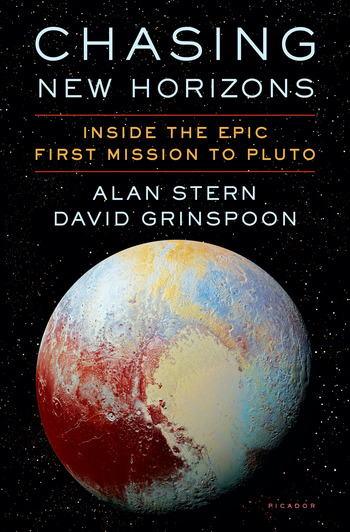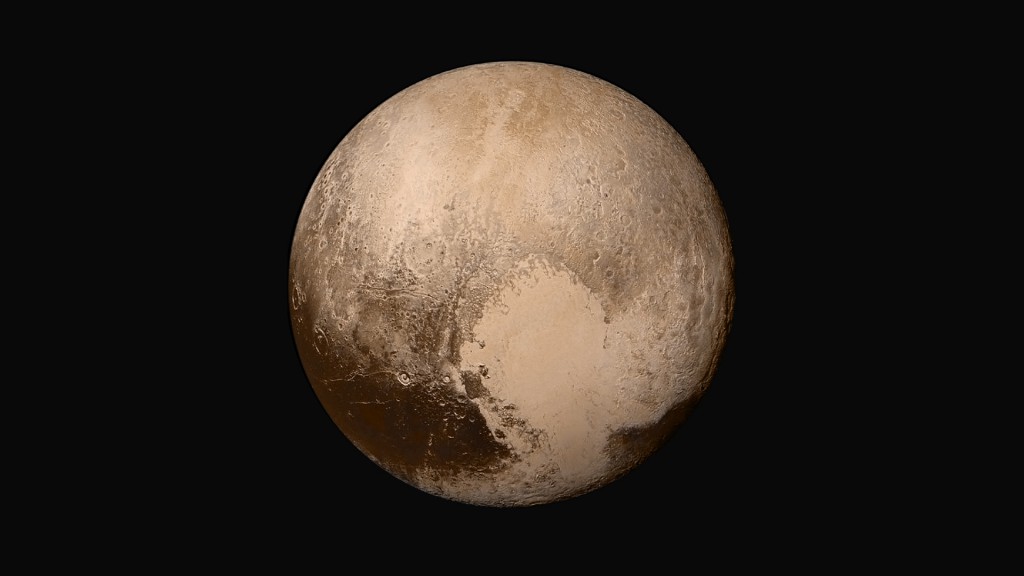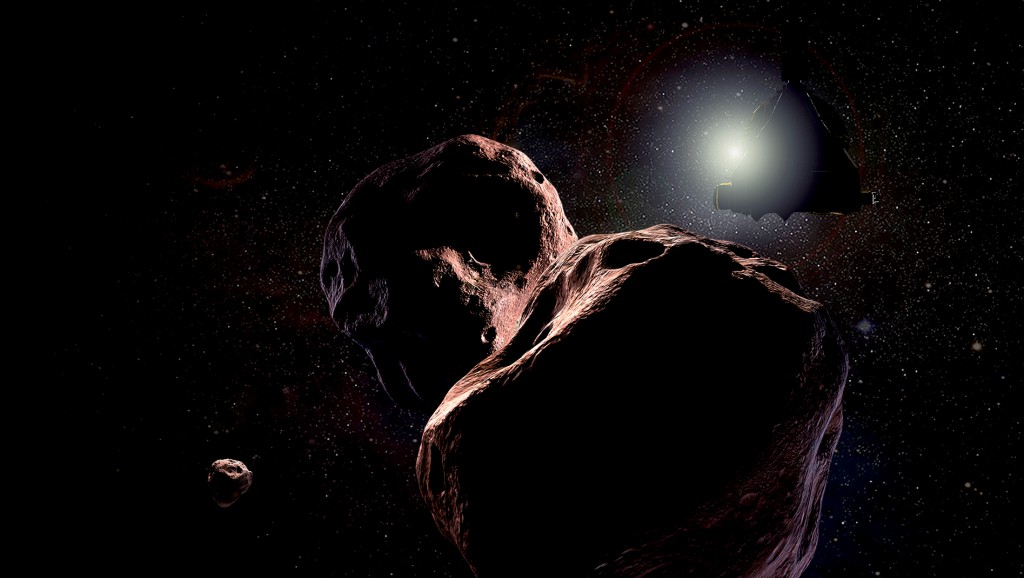Alan Stern on the Pluto Revolution, the Psychology of Persistence, and “Chasing New Horizons”
Posted on Categories Discover Magazine

In the 1970s, the original version of the Voyager mission was supposed to include a Pluto flyby–and Alan Stern worked through many failed attempts to launch a Pluto mission in the decades since. (Graphic: Jason Davis/The Planetary Society)
On July 14, 2015, the New Horizons spacecraft swept past Pluto, returning eye-popping images of the dwarf planet and its huge (relatively speaking) moon, Charon. At the time, the best existing images of Pluto showed nothing more than an enigmatic blur. New Horizons revealed a world of astonishing diversity: organics-coated dark patches, ice mountains, nitrogen glaciers, and methane snows, all in a state of astonishing activity considering the temperatures there are only about 40 degrees above absolute zero.
The scientific bonanza from the Pluto flyby was sweet vindication for Alan Stern, principal investigator on New Horizons. Stern spent decades fighting to make a Pluto mission happen, persisting long after it seemed like a hopeless cause. Teaming up with writer and astrobiologist David Grinspoon, Stern tells the full, thorny story in his engaging new book Chasing New Horizons: Inside the Epic First Mission to Pluto. It’s a a tale about space science, yes, but it’s also a reminder of what can happen when you refuse to let dreams die.
Myself, I’ve been chasing Alan for years, knowing that an interview with him would always yield a great story about scientific discovery. In addition to his work with New Horizons, he is a former NASA associate administrator, a private space entrepreneur, and the associate vice president of the Space Science and Engineering Division at Southwest Research Institute. Now he is preparing for New Horizons’ next act, a visit to a mysterious Kuiper Belt object called Ultima Thule (pronounced THOOL-ee) happening this December 31. And–as you will soon see–Stern is already thinking about the next few acts after that.
You’ve been through an epic experience, coming off the Pluto encounter and getting ready for Ultima Thule. How did you balance your work time with time to write this book?
Alan Stern: You don’t balance those things! The free perimeter in the whole equation was my sleep. I really haven’t slowed down on New Horizons or the other missions I’m working on. I was on one of the instruments on Rosetta. I am on the Europa mission science team, and the new Lucy Discovery mission science team. I run Southwest Research’s commercial suborbital program. I’m also board chairman for the Commercial Spaceflight Federation. So yeah, there’s a lot going on.
 One of the most striking themes in the book is how many times you proposed a mission to Pluto, only to get rejected over and over.
One of the most striking themes in the book is how many times you proposed a mission to Pluto, only to get rejected over and over.
What really counts is that when you get knocked down you stand up again. My saying to that is if the Pluto mission had been a cat, it would have been dead long ago! Cats only get nine lives. We got knocked down 11 or 12 times–I mean, to the point of having to start over. Even after we won approval there was a cancellation attempt. It’s not like New Horizons itself was smooth sailing. We had some near-death experiences.
So is the moral of the story: To succeed, you need to be a persistent mother*cker?
Do have the freedom to actually write that? It cuts both ways, to be quite honest. That’s a positive way of looking at it, and I wasn’t alone. Space flight is a team sport. But also there were times when I was taken aside, with fingers poked in my chest. People said, “This [push for a Pluto mission] is not good for your career. You need to stop this. This is costing you and your early in your career and people won’t forget. You can’t take ‘no’ for an answer.” I had to do some soul searching a couple of times about which way to go.
Was that always your personality—were you always determined to get your way?
In the book I tell a story about when I was a little kid. I was voraciously reading about space exploration, and when I ran out of everything in the library I wrote NASA over and over. All they would do is send me the same little silly pamphlets about space food and spacesuits. I finally had the gumption to call up the head of public affairs at NASA Johnson Space Center. I said, “I just saw the Apollo flight plan on CBS News with Walter Cronkite, and I would like one.”
The guy told me, “Listen, that’s for Walter Cronkite. We can’t just give those away.” He said, “If you were credited press I could justify it. But even a high school newspaper won’t count. You have to write a book or you have to write for a major magazine.” I was 14.
What did you do? You started writing for magazines at age 14?
No, I realized that nobody’s going to hire me to write for a magazine, but I could write a book. So that summer I wrote a book and my grandfather had a secretary type it up. It was about 150 pages, double spaced. We sent it to John McLeish, this guy in public affairs. He took one look at it and basically cried uncle. He called me up and said, I’m sending you the flight plans. That book was never published, of course. I wrote it just to get over the barrier to entry.
Were there any times when you thought, “I give up, this Pluto mission just isn’t going to happen?”
In the fall of 2000, Ed Weiler [associate administrator for NASA’s Science Mission Directorate] canceled what was then called the Kuiper-Pluto Express. He held a press conference and said, not only have we issued a stop-work order but we are not going to study any more Pluto missions. He said it is “dead dead dead”—he repeated it three times. Everything we’d worked on for 11 years was suddenly swept away.
That’s when we started calling in favors. An incredible number of people pitched in across the planetary science community in the U.S. and in Europe. The Planetary Society with Lou Friedman was hugely supportive. Bill Nye was individually supportive. Neil Tyson was supportive. There was a lot of public support to put that Humpty Dumpty back together again.
How do you rebound from being told your mission is “dead dead dead”?
Weiler invented this idea that rather than go back to JPL and try again, that NASA would treat [our Pluto concept] like a new style of mission and to let teams compete for it. He announced in December, 2000, that the agency was going to issue an announcement of opportunity in 30 days. Teams didn’t even know that they would exist had to form out of nowhere over the Christmas holidays and then do all the engineering and science development work it takes to write those proposals. It was a Herculean for everybody involved.
How were you able to pull a whole new Pluto proposal together so quickly?
One thing that you may not appreciate is that I’ve worked on 29 space missions. People typecast me, like on Gilligan’s Island. They think of me as “Mr. Pluto.” They don’t realize the other 28 missions I’ve been on. A lot of the lessons that helped make Pluto happen came from those other experiences.

The iconic image of Pluto and its giant “heart”–an ancient impact basin filled with nitrogen ice, possibly with liquid water lurking below. Planetary scientists are still trying to make sense of the wildly diverse terrain on Pluto. (Credit: NASA/JHU-APL/SWRI)
Still, there’s something special about Pluto that kept you so focused. What mad a Pluto mission so much more enthralling than all those others?
There were really three things. One is, scientifically, I’d worked a lot on Pluto and knew it was fascinating. I also knew that we weren’t going to figure it out without getting a space mission. We reached a wall by the early 1990s, after the first Hubble images. There weren’t going to be any future big breakthrough unless we went there.
The second thing is that I have always had a love of exploration for its own sake. The first missions to each planet were always the most prized missions. When I got out of grad school in the 1980s, we didn’t know about the Kuiper Belt, so we used to call [going to] Pluto “the first mission to the last planet.” It would be the the capstone to the reconnaissance the planets—our last train to Clarksville. That was very powerful.
And third, there was the invested effort and the unfair things that happened. At some point, I and others felt that there was a wrong that needed to be righted. There was a time when we were told a cancellation took place because we were over budget—and we didn’t even have a budget! There were instances when we thought, People are doing things for reasons other than what they’re saying.
So partly, you wanted justice for Pluto?
There’s nothing more to get your back up than when you feel wronged. Those things together—the science, the exploration, and the borderline anger some people in this community felt, that we’ve been mistreated—it was a hypergolic combination.
When you started thinking about Pluto, nobody knew about the Kuiper Belt. How did the new discoveries change your view of Pluto?
After Jewitt and Luu’s paper was published in 1993, Pluto went from being a misfit—a fascinating body that didn’t fit the pattern of the terrestrial planets or the giant planets—to being the harbinger of the most populous class of planets in the solar system. What we used to think of the outer planets are now the middle zone of the solar system. There are forensic clues in the Kuiper Belt that the planets rearranged their orbits in a violent way very early on. Those discoveries were transformative.
Pluto rose in stature through that process. Instead of the first mission to the last planet, going there would begin a whole new chapter of exploration.
Then when you got there, Pluto turned out to be highly complex and dynamic, despite a temperature of about -230 degrees C (-370 F). Were you surprised?
I knew would be good. I remember once you tried to pry predictions out of me and I all I’d say was, “We’ll find something wonderful.” But Pluto turned out to be the belle of the ball.
It’s a geologist dream. It’s a cosmochemist’s dream. If you like ocean worlds, well Pluto’s got that, too. If you like a really complicated atmosphere that defies imagination, that’s Pluto. It’s got a spectacular system of satellites. It’s the archetype for this whole new class of small planets in the Kuiper Belt that are just as diverse as the terrestrial planets. On top of all that, it’s got this thousand-kilometer-wide heart on it: a little planet with a big heart that captured people’s imagination.

An artist’s impression of what the Ultima Thule encounter may look like when New Horizons sweeps past on December 31, 2018. The object seems to be binary or double-lobed; beyond that, we know very little about it. (Credit: NASA/JHU-APL/SWRI/Steve Gribben)
Here, I’ll try again. What do you expect to see when New Horizons reaches Ultima Thule at the end of this year?
We don’t know enough about it to predict. It’s certainly ancient and pristine, and we’ve never seen anything like it.
Your book is in some ways only the beginning of the story, since there’s still a lot more to learn from the New Horizons mission, right?
Oh yes! We did over 450 separate scientific observations with seven instruments. We looked at all five satellites and Pluto. We’ve been skimming the cream but we haven’t until very recently been doing the in-depth analysis and synthesis and modeling to understand why things are the way they are. It will probably be a decade before the data sets have been thoroughly gone over.
Also, we have we have power and fuel to run New Horizons for another 20 years. We’re currently funded for an extended mission through 2021, but we have every intention of proposing mouthwatering science and maybe another Kuiper Belt flyby in the three years following that. Then we’ll probably be finished with observations of Kuiper Belt objects somewhere around 2024.
There’s another possible flyby after Ultima Thule? That’s news to me.
Like all extended missions, we’re on a tight budget compared to the prime mission. We’re just keeping our heads down making sure that Ultima Thule works out. We’re not really going to think in depth about that mission until a year from now, after the first Ultima Thule papers are out. But we’re the only spacecraft ever planned to go to the Kuiper Belt. We need to milk it for everything we can, because it may be a very long time before something is out there again.
Farther ahead, the instrumentation on New Horizons for studying the heliosphere is very powerful compared to what’s on the Voyagers, so you can look at much finer structures and much quicker time variations. They also don’t have instruments like our dust counter. The space physics community is very interested in are flying out the Sun’s termination shock by the 2030s.
I’ll be the optimist and assume we will return to the Kuiper Belt. Where should we go next?
This is the big question: Should we go back to Pluto and orbit it and study it in depth, or should we go to two or three more dwarf planets and sample the diversity of the Kuiper Belt? Let me give you an example of an architecture that would be spectacular for Kuiper Belt science.
There’s a big push to do missions to Uranus and Neptune. Orbiting both of them is probably not affordable, so people in the community are now talking about combined missions. One would put an orbiter around Neptune. As a part of that it would study [Neptune’s giant moon] Triton, which itself is a Kuiper Belt planet now trapped in orbit around Neptune.
Then we would send a second spacecraft, much like New Horizons, on a Uranus flyby and use Uranus for a gravity assist to another Kuiper Belt planet. In the process Uranus would get a flyby visit, not as in-depth as Neptune, but still a very important step forward. With Triton, Pluto, and this third Kuiper Belt planet we would have really started to look at the diversity of these objects.
For space, astronomy, and physics news as it happens, follow me on Twitter: @coreyspowell